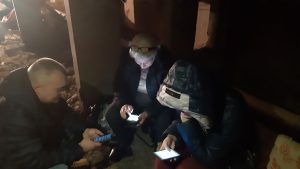Internally displaced Ukrainians struggle with food, shelter
Twelve months after Russia launched its invasion, about 5.3 million Ukrainians, representing 12 per cent of the pre-war population, are displaced within the country.
Aid agencies report that many of these internally displaced persons (IDPs) are struggling with their most basic needs, with the elderly and people with disabilities among the most vulnerable.
A recent statement from the International Red Cross indicated that even special shelters established to house evacuees were struggling to cope.
“Internally displaced people both in collective shelters and hosted in private homes, still lack firewood, warm clothing and blankets, electric heaters and electric generators, and cash for utilities, as the country continues to confront cold winter temperatures,” the IRC said
 In total, around 13.4 million people have been displaced by the Russian invasion, including eight million refugees who have fled overseas.
In total, around 13.4 million people have been displaced by the Russian invasion, including eight million refugees who have fled overseas.
Internal displacement in Ukraine peaked in early May last year, three months after Russia’s invasion began, at slightly more than eight million.
Since May, almost 5.6 million people have returned to their homes.
But aid agencies say it may be difficult to determine whether these returns will be permanent.
Predictions that there would be new exodus of refugees from Ukraine to EU countries as Russian attacked electricity and energy infrastructure has not eventuated.
But hundreds of thousands more people have been internally displaced by ongoing fighting in the east and the south of the country in recent months – some for the second or third time.
Almost two million of Ukraine’s IDPs are in the east of the country, living in areas heavily affected by the war, including close to the front lines, Ukrainian authorities say.
About 80 per cent of damaged houses and flats in Ukraine are situated in the north and the east of the country, in the Donetska, Luhanska, Kharkivska, and Kyivska oblasts, which have seen the heaviest ground fighting and destruction, aid agencies say.
Among those Ukrainians still close to the front lines are a large number of elderly people and people with disabilities.
They mostly lack the financial ability to relocate away from the fighting and have had little choice but to move in with family and friends living nearby.
In western Ukraine there are around 860,000 IDPs. But many cannot afford rent, and with low-cost housing options limited in the safer parts of the country, hundreds of thousands of people have ended up taking shelter in some 7,200 collective centres – many of them ill-equipped to meet long-term needs.
NGOs are working with local authorities to try to make sure those staying in the centres have heating, water, food, and bathing facilities.
They also try to provide psychosocial support services, including for children traumatised by the war. But employment opportunities are hard to come by, and people’s resources often run out.












